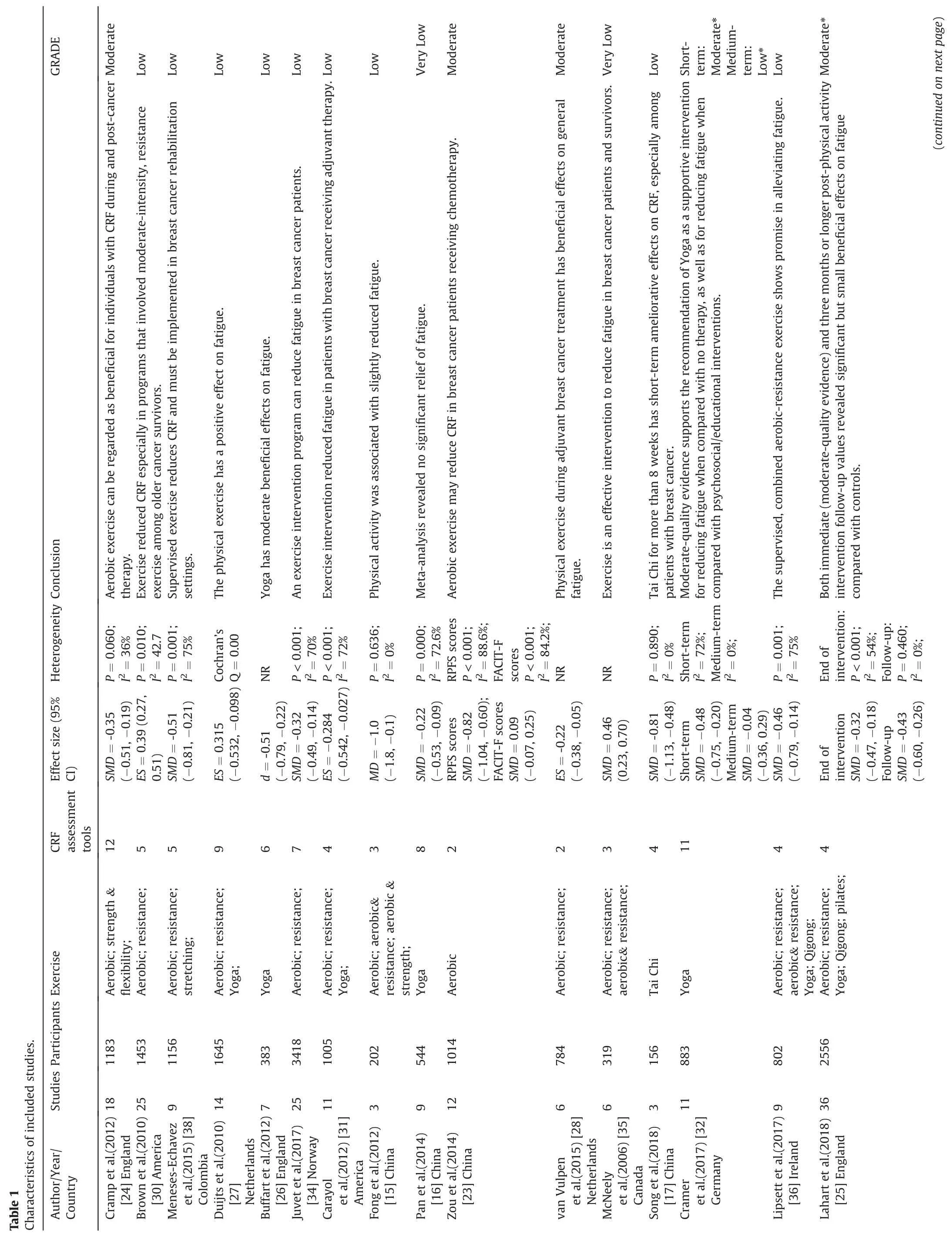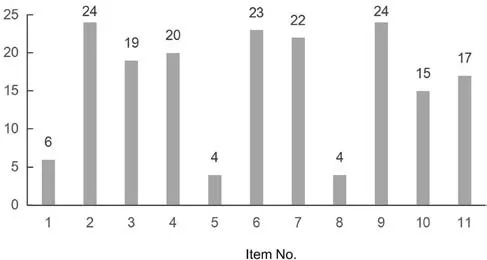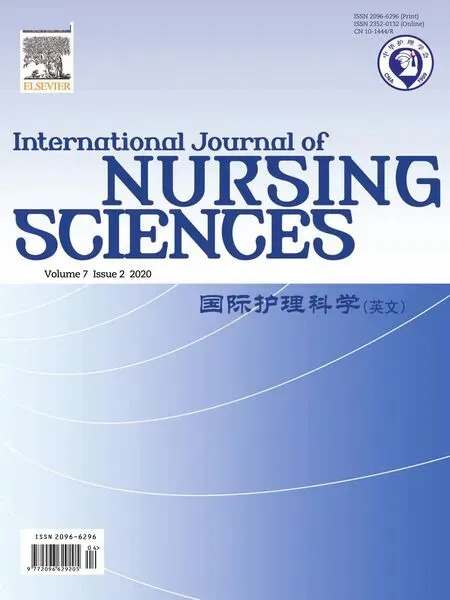Exercise for fatigue in breast cancer patients:An umbrella review of systematic reviews
Mengyo Jing ,Yuxi M ,Bei Yun ,Qing Wng ,Cn Hung ,Lin Hn
a School of Nursing,Lanzhou University,Lanzhou,Gansu,China
b Evidence-Based Nursing Center,School of Nursing,Lanzhou University,Lanzhou,Gansu,China
c Department of Nursing,Gansu Provincial Hospital,Lanzhou,Gansu,China
Keywords:Breast neoplasms Exercise Fatigue Yoga
ABSTRACT Objective:To evaluate evidence from published systematic reviews about the effectiveness of exercise interventions on fatigue management in breast cancer patients.Methods:PubMed,Web of Science,the Cochrane Library,the Cumulative Index of Nursing and Allied Health (CINAHL),Embase databases,the China National Knowledge Infrastructure (CNKI),the Wanfang database,the China Biomedical Literature Database (CBM),and the VIP database were searched to identify relevant systematic reviews.The reviews which assessed exercise interventions on cancerrelated fatigue (CRF)in breast cancer patients were included.Quality of evidence was evaluated by the Grade of Recommendation,Assessment,Development,and Evaluation(GRADE)tool.The Assessment of Multiple Systematic Reviews(AMSTAR)appraisal tool was used to evaluate the methodological quality of included systematic reviews.Results:Twenty-four systematic reviews met all the inclusion criteria.The overall mean score for AMSATR is 7.38 and ranged from 4 to 10 points.In addition,21 reviews arrived at positive conclusions,which exercises could reduce CRF,and 3 obtained that exercise does not affect fatigue.As for GRADE,8 of the reviews were graded as ‘moderate’,2 of the studies were ‘very low’,and the others were ‘low’.Conclusions:Aerobic and resistance exercise can be regarded as beneficial to CRF in breast cancer patients,and limited evidence exists that yoga had an effect on reducing fatigue.The quality of the current systematic review is still far from satisfactory.
What is known?
· Breast cancer is the most frequently diagnosed cancer among women.
· Considerable systematic reviews have been conducted in understanding the effect of exercise on cancer-related fatigue(CRF).
· Exercise is an acceptable intervention in breast cancer patients,with minimal negative effects.
What is new?
· Aerobic and resistance exercise can be regarded as beneficial to CRF in breast cancer patients.
· The methodological quality of the included systematic reviews still needs to improve.
· High-quality evidence for the effectiveness of exercise interventions is limited.
1.Introduction
Breast cancer is the most frequently diagnosed cancer and the leading cause of cancer death among women,followed by colorectal and lung cancer for incidence,and vice versa for mortality[1,2].There will be approximately 2.09 million new cases of breast cancer in 2018 [3].The incidence rate of breast cancer was stable over the past few decades [4,5].Increasing life expectancy and declines in infection-related diseases are offset by an upsurge in cancers more common in wealthier countries and associated with a so-called western lifestyle.The prevalence of breast cancer is expected to increase rapidly with human development [1].
Fatigue is a pervasive symptom in patients with cancer and is nearly universal in those receiving chemotherapy and/or radiotherapy [6].Cancer-related fatigue (CRF)is a disturbing and debilitating symptom and negatively impacts daily functioning [7],including an ongoing reduction in physical activity,sleep quality,and increasing depression,anxiety and mood disturbance.These detrimental effects contribute to the low quality of life and probably lead to a heavy financial burden for family and society [8].To identify efficacious clinical management strategies are therefore needed [9].Exercise is a cost-effective,accessible,and relatively simple method with minimal side effects of decreasing fatigue[10].
Considerable systematic reviews have been conducted in understanding the effect of exercise on CRF.However,these reviews vary in scope,quality,and methodology,and at times report diverse findings which can cause great confusion [11].It is necessary to perform an umbrella review of these systematic reviews to inform future related trials and policy.Therefore,the aim of this study was to present an umbrella review of the range and validity of the diverse exercise interventions targeted at reducing CRF among breast cancer patients and provide recommendations for future research.
2.Methods
2.1.Search strategy
A comprehensive search was performed in PubMed,Web of Science,the Cochrane Library,the Cumulative Index of Nursing and Allied Health (CINAHL),the Embase databases,the China National Knowledge Infrastructure(CNKI),the Wanfang database,the China Biomedical Literature Database(CBMdisc),and the VIP database till October 2019.The relevant Medical Subject Headings(MeSH)terms and free text included four themes “exercise”,“breast cancer”,“fatigue”,and “systematic review” (see Table I in Appendix A).We manually searched the references of selected articles for any additional studies that were not captured by the electronic search.And all obtained articles stored in EndNote X8.
2.2.Inclusion and exclusion criteria
The inclusion and exclusion criteria followed the PICO framework:(1)Types of Participants:Adults (>18 years)with breast cancer diagnosis,but recruited females aimed to breast cancer prevention or no data could be extracted for a sample of breast cancer patients were excluded;(2)Types of Interventions:Studies which involved specific exercise interventions,such as aerobic training,resistance training,Yoga,Tai Chi,Qigong and so on,Studies with too few details available about the exercise intervention or involved drug-based interventions were excluded;(3)Types of Comparison:Not specified;(4)Types of Outcome measures:CRF was the primary outcome;(5)Other:publication type is systematic review and meta-analysis.The language published was in English or Chinese.
2.3.Study selection and data extraction
After duplicates removed,two investigators (Jiang and Yun)independently assessed the eligible systematic reviews(SRs)/metaanalyses (MAs)according to inclusion and exclusion standards via screening titles and abstracts.After that,relevant full-text articles were obtained for selecting.Any disagreements were resolved by discussion.Data were extracted from the eligible studies by two independent investigators (Jiang and Yun),which includes the following items:title,first author,publication year,country,number of studies that assessed fatigue in breast cancer patients,number of participants with breast cancer,exercise intervention,outcome measured and conclusion.All extracted data were stored in the Microsoft Excel file format.
2.4.Quality appraisal
Two investigators (Jiang and Yun)independently assessed the methodological quality of included SR/MAs using the Assessment of Multiple Systematic Reviews (AMSTAR)rating scale.The AMSTAR with 11 questions is a reliable and valid tool,which can be successfully used in overviews[12,13].Items were rated as‘0’,or‘1’.If no sufficient information was available in the article or a criterion was lacking,this item was scored ‘0’.If sufficient information was provided and bias was unlikely,the item was rated ‘1’.Any disagreements about the rating were resolved through discussion.We defined thresholds for total AMSTAR scores to designate low(0-3),moderate(4-7),high (8-11)quality reviews.
In addition,the Grade of Recommendation,Assessment,Development and Evaluation(GRADE)tool[14]was used to assess the quality of evidence for breast cancer patients’fatigue outcome on 4-grade(high,moderate,low and very low quality).According to the GRADE handbook,there are five factors reducing the quality of the evidence,including 1)limitations in study design;2)inconsistency of results;3)indirectness of evidence;4)imprecision;5)publication bias.We defined that use the risk bias tool to assess the included clinical trials and the result showed more than half trials’bias was moderate or high will downgrade on the study limitation,‘I2statistic is larger than 50% and P-value is lower than 0.05’ will downgrade on the inconsistency,‘differences in population,interventions,comparisons,outcomes measures (PICO)’ will downgrade on the indirectness,‘a(chǎn) wide confidence interval (CI)and the sample was fewer than 400 participants’ will downgrade on the imprecision,and ‘publication bias was assessed to exist’ will downgrade on the publication bias.And discrepancies were resolved by discussion.
3.Results
3.1.Study process
Our search retrieved 1333 articles,of which 221 were duplicates.After screening titles and abstracts,81 reports remained and were evaluated in detail.Of these,we excluded 57 studies with reasons that fatigue was not primary outcome focus(n=21);without specially discussion about breast cancer(n=17);without statistical value(n=12);interventions related to acupuncture or massage(n=4);published in Spanish(n=2);and not mention the exact exercise intervention(n=1).A PRISMA diagram is shown in Fig.1.
3.2.Characteristics of included studies
The main characteristics of the 24 included reviews are summarized in Table 1.The 24 SRs/MAs included four from the Cochrane Library.Of the 24 included studies,nine articles originated from China[15-23],three from England[24-26],three from Netherlands [27-29],the rest are from America [30,31],Germany[32,33],Norway[34],Canada [35],Ireland [36],Australia [37],and Colombia[38].The number of participants varied widely from 156 to 3418.In addition,each systematic review included original trials of which sizes ranged from 3 to 36.The number of tools to assess CRF varied from 2 to 13.The included reviews were published in 2010 or later,except one in 2006 [35].The Meta-analyses all included randomized clinical trials.

Fig.1.PRISMA flow diagram for search and selection process.
As for the GRADE,8 of the reviews were graded as‘moderate’,2 of them were ‘very low’,and the others were ‘low’ (see Table II in Appendix A).
Three studies’ results [16,18,22]show that there were no significant differences between the exercise group and the control group.And two of them were graded as ‘low’,one was ‘very low’.They were all from China.
3.3.Methodological quality of included studies
The overall mean AMSTAR methodological quality score for included systematic reviews was 7.375 and ranged from 4 to 10 points.None reviews achieved a perfect score of 11/11,though four reviews achieved 10/11,one review scored 9/10,four reviews achieved 8/11,six reviews scored 6/11 and one scored 4/10.Therefore,nine reviews were high methodological quality articles,the others were moderate.(see Table III in Appendix A).Fig.2 provided the total score of each item of AMSTAR evaluation.
4.Discussion
Our umbrella review provides a comprehensive assessment of the evidence of the effectiveness of exercise interventions applied for reducing CRF in breast cancer patients.However,high-quality evidence for the effectiveness of these exercises is limited.


The result indicates that a broad range of exercise approaches were applied,such as aerobic,resistance,strength,flexibility,Yoga,Tai Chi,Qigong,and Pilates.Of 24 included studies,18 reviews evaluated aerobic training.Aerobic exercise is perhaps the most common accessibility and affordability which involves training of the cardiovascular system under aerobic conditions[39].It includes activities like brisk walking,running,swimming or cycling.Our result indicated that aerobic exercise is a supportive intervention on reducing CRF and the quality of evidence was graded as moderate.These activities are cost-effectiveness and should be popularized in clinical practice.There are 14 reviews appraised resistance exercise.Resistance exercise is aimed to rebuild muscle mass and improve functional limitation.The resistance,flexibility and strength training (RFST)offers immediate,cumulative,and permanent increases in flexibility and protects one from injuring themselves by over-stretching.Current research evidence suggests that both aerobic and resistance exercise programs are effective in ameliorating CRF[40].We included 11 reviews assessed Yoga.Yoga is a traditional Indian spiritual practice which consists of a series of postures (asanas)that are combined with deep diaphragmatic breathing(pranayama)and meditative techniques[41].Only three studies’results showed that exercise intervention had no effect on reducing fatigue,which were all linked to Yoga.Though Yoga has been widely accepted as a popular means of promoting physical and mental wellbeing,the versatility of Yoga,the difference in patients(age,treatment modalities,stage)[42],fatigue characteristics(intensity,distress,and interference)[43],volume(frequency,intensity,duration),setting(physical and social environment),and outcome measures [40]may all lead to the various results.Hence,whether Yoga could alleviate fatigue among breast cancer patients needs further rigorous randomized controlled trials.Additionally,a paucity of reviews evaluated the effectiveness of the alternative exercise traditions(Tai Chi/Qigong,Pilates and so on).The included review about Tai Chi revealed that it has short-term ameliorative effects on CRF and the evidence was weak.And the research of Pilates in breast cancer is scarce,so the effect of Pilates is still unclear.
Considering the various results,it may be attributed to the following reasons.First,exercise interventions are complex interventions[44].Many trials have tested interventions without first considering the mechanism of action and that was not specially designed to manage fatigue.For example,interventions that aimed to reduce anxiety or depression showed that fatigue did not decrease with anxiety or depression,which leads to conclude that these exercise interventions are not effective for reducing fatigue.Second,we rated the quality of the included evidence using the GRADE system varied from very low to moderate quality,which largely due to the study design limitation.It is generally regarded as impossible to blind participants and especially personnel in exercise studies [24].Lack of blinding of participants and personnel might have introduced bias.Third,fatigue is an abstract,multidimensional subjective experience and has significant clinical importance.Currently,there are various tools for assessing CRF.For example,the Brief Fatigue Inventory (BFI)comprises nine items measured on a ten-point scale that assesses the severity of fatigue,however,the functional assessment of cancer therapy fatigue scale(FACT-F)consists of the 28 items of the FACT general,to assess health-related quality of life,and an additional 13 items to assess fatigue[7].Their results can be ambiguous in terms of what is being measured.
With regard to the methodological quality,the AMSTAR scores show that the majority were of high methodological quality.Nevertheless,as for item #5,‘Was a list of studies (included and excluded)provided?’,only the Cochrane reviews provided an explicit list of excluded studies and stated the recommendations due to the rigorous reporting standard of the Cochrane library.Additionally,the item#8,‘Was the scientific quality of the included studies used appropriately in formulating conclusions?’,these included reviews that assessed the publication bias always without bias,in contrast,the unreported publication bias is worth exploring whether it exists.

Fig.2.Total score of 24 reviews for each item of AMSTAR.
This umbrella review only included studies written in English and Chinese.In addition,the result of our umbrella review all relies on previous SRs/MAs,the possibility exists that trials with negative results might not have been reported so that missed in our search.Besides the current reviews included most of trials assessed the short-term (less than 6 months)effectiveness of exercise on CRF which is a potential source of heterogeneity.However,CRF is a chronic symptom,and it would be advisable to include the longer follow-up period (beyond 6 months post-randomization)because long-term intervention could better prove its effect on fatigue management [45,46].Based on the above,it has been possible to suggest key components of future exercise interventions for fatigue in breast cancer patients.Firstly,future research is required to clarify the effectiveness of different intervention modalities (frequency,intensity,time and type)for breast cancer patients with fatigue to allow determination of exercise dose-response.Secondly,it is essential for future randomized controlled trials and Metaanalyses should not only focus on the effects of exercise on fatigue but also how to improve breast cancer patients’adherence to exercise protocols.Thirdly,additional studies are needed to evaluate the cost-analysis and adverse events of exercise.Fourthly,there is an urgent need for innovative methods to generate highquality evidence.
5.Conclusion
In summary,aerobic and resistance exercise can be regarded as beneficial to CRF in breast cancer patients.But the other exercise type has limited evidence to prove its effectiveness owing to the insufficient and low-quality trials.The quality of the current systematic reviews is still far from satisfactory and it is still challenging in CRF management.Future research is required to focus on the application of novel research designs,high-quality trials with longterm follow-up,and the optimal dose of exercise.
Funding
National Natural Science Foundation of China of China (grant 71363004,71663002,71704071),the Fundamental Research Funds for the Central Universities (lzujbky-2016-ct14,lzujbky-2018-ct05,lzujbky-2018-77),National Research Training Program of Gansu Provincial Hospital (19SYPYA-4).
Declaration of competing interest
The authors declare no conflict of interest.
CRediT authorship contribution statement
Mengyao Jiang:Formal analysis,Writing -original draft,Writing-review&editing.Yuxia Ma:Conceptualization,Writingreview &editing.Bei Yun:Formal analysis,Writing -review &editing.Qing Wang:Writing -review &editing.Can Huang:Writing -review &editing.Lin Han:Supervision.
Acknowledgement
None.
Appendices.Supplementary data
Supplementary data to this article can be found online at https://doi.org/10.1016/j.ijnss.2020.03.001.
 International Journal of Nursing Sciences2020年2期
International Journal of Nursing Sciences2020年2期
- International Journal of Nursing Sciences的其它文章
- Antiretroviral therapy improves neurocognitive impairment in people living with HIV? A meta-analysis
- Intervention effect of neuromuscular electrical stimulation on ICU acquired weakness:A meta-analysis
- Psychometric properties of the Chinese Version of the Readiness for Hospital Discharge Scale for people living with HIV
- Experiences of graduates in Massachusetts of the United States from a RN-to-BSN program
- Analysis on nursing competence and training needs of dementia caregivers in long-term care institutions
- Investigation for the transcultural self-efficacy of nurses in Guizhou,China
